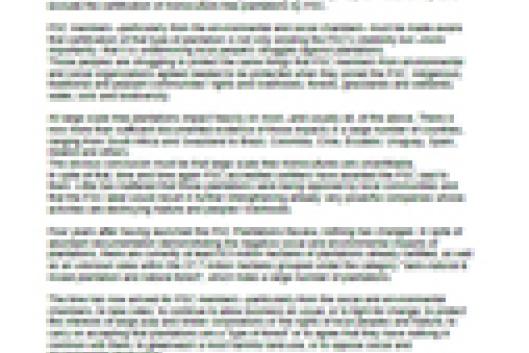Solo disponible en inglés.
By Geasphere, South Africa
Since 2004,21st September is a special day used to raise awareness about the impacts of large-scale timber plantations, to encourage action, to highlight alternative ‘forestry’ models andto celebrate the progress made in the resistance against the industrial timber production model.Sustained resistance is critical, because timber plantations seriously affect the long-term ecological sustainability in areas where they have been established.
In Mpumalanga province, South Africa, timber plantations have the most obvious impacts on the indigenous grassland biome. Vast tracks ofindigenous grassland, which containsa great diversity of plant and animal species, were converted to massive monocultures of alien invasive trees, mainly Eucalyptus and Pine. These alien species are used because of their fast growth and the absence of their natural predator pests. Environmental and social impacts are dire but take a back seat to economic considerations. Timber plantations ‘shade out’ the grassland plants, which cannot adapt and live underneath timber plantations. Diverse and rich areas flourishing with life of indigenous species turn into ‘green deserts’. In fact, after approximately two rotations of timber, it becomesalmost impossible to rehabilitate the grassland, as seeds, bulbs and roots are not able to survive.
Timber plantations utilize soil nutrients, but the natural processes, which ‘replace’ these nutrients, are absent. Thus, timber plantations are said to ‘mine the soil’. This leads to medium and long term soil nutrient depletion, which makes soil rehabilitation and alternative productive use very difficult.
In most areas planted to timber, soil erosion is a growing problem. Grassland services include ‘water retention’, because the grass and roots act like a ‘sponge’ to absorb rainfall, releasing it slowly to underground aquifers. As timber plantations replace the grasslands, these services are compromised,which causes the soil to being washed away. Rivers in surrounding valleys become tainted withsilt anddirtyand organisms living in the aquatic habitats become threatened with localized extinction.
Timber plantations utilize vast quantities of water.Timber plantation trees are fast-growing and evergreen, indicating that they can consume water throughout the year. Eucalyptus roots have been measured at 50m into the soil profile, capable of fracturing rocks in their quest to reach the groundwater resource. In a Water Research Commissionreport, it was shown that after planting a catchment in Mpumalanga to eucalyptus plantation, springs and small streams dried up after 3 years. When the plantation was clear felled and removed after 16 years, it took 5 years before the water re-surfaced. In Zambezia province, Mozambique, communities living close to plantations have reported that wells started to dry up a few years after plantation establishment and that they were having problems to water their own livestock and vegetable fields.It is just not right that people have to compete against plantations for water - which is essential to basic survival.
The growing of timber plantations does not provide many employment opportunities. The industry is heavily mechanized, with massive machines performing the work of hundreds of people. Poverty becomes worse as the unemployment rate increase and it becomes difficult to produce food in the local economy, as the land had beenconverted to timber plantation estates. In one sentence: Less diversity, less money, less food.
Alternative, more appropriate land use models exist and should be adopted in the ‘forestry’ sector. It has been proposed that timber companies transform their models from utilizing alien, fast-growing and high impact tree species to cultivating indigenous trees in a diversified, ‘agroforestry’ system, for a long rotation, high value timber product. It is essential that animals become part of the ‘farming’ system to ensure natural organic nutrient recycling.Agroecological approaches to landscape systems – applying ecological concepts to design and implement ecologically and socially sustainable agricultural systems – should be utilized to ensure divers and socio-economically beneficial timber growing operations. For instance, some timber companies still successfullyutilize horses and mules in extraction operations, which cut down on fossil fuels, meaning reducedemissions, less compaction andmore employment due to each animal requiring a handler.
More than 1.5 million hectares in South Africa are covered with timber plantations, primarily in the eastern escarpment region with appropriate soils and a high enough rainfall (650mm+/annum). In Mpumalanga – the province most affected by timber plantations – the authorities recognize the problems associated with high water use and it has become difficult to obtain a ‘license’ for timber plantation expansion. However, especially in the Eastern Cape Province, plantations are still being promoted as a means of ‘rural development’.
Now is the time to raise our voices and to join the struggle to stop the expansion of monoculture tree plantations, and to demand that diverse, ecologically appropriate land use models be promoted, with respect for the environment and the right of local peoples.
GeaSphere supports the ‘No to ProSavana’ Campaign, in opposition to the destruction of Mozambique Savana Forests by transformation to support large-scale agribusiness.
GeaSphere rejects the findings of the FSC Formal complaints committee –who ruled that it is just for Timber Companies to ‘trap and shoot’ thousands of indigenouschacma baboons in an effort to control ‘baboon damage’. We believe it is possible to find ‘non lethal’ methods of damage control which would involve the creation of ecological corridors, landscape restoration and rehabilitation.
Plantations are Not Forests!
